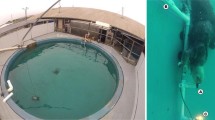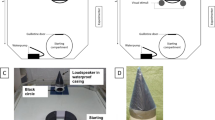Summary
-
1.
The ability of adultXenopus laevis to discriminate water waves of different frequencies was tested by go/no-go conditioning.
-
2.
In the range 5–30 Hz,Xenopus can distinguish waves on the basis of frequency. In this range, the relative discrimination limen DL had an optimum of 0.04 at 14 Hz and increased to 0.15 one octave above and below (Fig. 3). When the relative difficulty of the conditioning paradigm is taken into account, this discrimination acuity is in the range of vertebrate auditory discrimination.
-
3.
Frequency discrimination was not limited to surface waves, but was also performed when the frog was sitting on the bottom of the basin.
Similar content being viewed by others
Abbreviations
- S+ :
-
stimulus with response reward
- S−:
-
stimulus with response punishment
- †f :
-
frequency difference of the two waves being tested
- DL :
-
relative discrimination limen †f/f
References
Bachem A (1964) Time factors in relative and absolute pitch discrimination. J Acoust Soc Am 26:751–753
Bleckmann H (1980) Reaction time and stimulus frequency in prey localization in the surface-feeding fishAplocheilus lineatus. J Comp Physiol 140:163–172
Bleckmann H, Barth FG (1984) Sensory ecology of a semiaquatic spider (Dolomedes triton). II. The release of predatory behavior by water surface waves. Behav Ecol Sociobiol 14:303–312
Bleckmann H, Schwartz E (1982) The functional significance of frequency modulation within a wave train for prey localization in the surface-feeding fishAplocheilus lineatus (Cyprinodontidae). J Comp Physiol 145:331–339
Bleckmann H, Topp G (1981) Surface wave sensitivity of the lateral line organs of the topminnowAplocheilus lineatus. Naturwissenschaften 67:624
Bleckmann H, Waldner I, Schwartz E (1981) Frequency discrimination of the surface-feeding fishAplocheilus lineatus — a prerequisite for prey localization? J Comp Physiol 143:485–490
Böttger K (1974) Zur Biologie vonSphaerodema grassei ghesquierei. Studien an zentralafrikanischen Belostomiden (Heteroptera, Insecta) I. Arch Hydrobiol 74:100–122
Burdick CK (1979) The effect of behavioral paradigm on auditory discrimination learning: a literature review. J Auditory Res 19:59–82
Burgess JW, Shaw E (1981) Effects of acoustico-lateralis denervation in a facultative schooling fish: A nearest-neighbor matrix analysis. Behav Neural Biol 33:488–497
Dijkgraaf S (1947) Über die Reizung des Ferntastsinns bei Fischen und Amphibien. Experientia 3:206–208
Dijkgraaf S (1967) Biological significance of the lateral line organs. In: Cahn P (ed) Lateral line detectors. Indiana University Press, Bloomington, pp 83–95
Dooling RJ (1982) Auditory perception in birds. In: Kroodsma DE, Miller EH, Ouellet H (eds) Acoustic communication in birds, vol 1. Academic Press, New York, pp 95–130
Elepfandt A (1982) Accuracy of taxis response to water waves in the clawed toad (Xenopus laevis Daudin) with intact or with lesioned lateral line system. J Comp Physiol 148:535–545
Elepfandt A (1984a) The role of ventral lateral line organs for water wave localization in the clawed toad (Xenopus laevis). J Comp Physiol A 154:773–780
Elepfandt A (1984b) Operante Wellenformkonditionierung beim Krallenfrosch (Xenopus laevis Daudin). Verh Dtsch Zool Ges. 77:227
Fay RR (1974) Auditory frequency discrimination in vertebrates. J Acoust Soc Am 56:206–209
Goff GD (1967) Differential discrimination of frequency of cutaneous mechanical vibration. J Exp Psychol 74:294–299
Gulick WL (1971) Hearing: Physiology and psychophysics. Oxford University Press, New York
Heffner RS, Heffner HE (1982) Hearing in the elephant (Elephas maximus): Absolute sensitivity, frequency discrimination, and sound localization. J Comp Physiol Psychol 96:926–944
Hodos W, Campbell CBS (1969) Scala naturae: Why there is no theory in comparative psychology. Psychol Rev 76:337–350
Hoin-Radkovsky I, Bleckmann H, Schwartz E (1984) Determination of source distance in the surface-feeding fishPantodon buchholzi Pantodontidae. Anim Behav 32:840–851
Kramer G (1933) Untersuchungen über die Sinnesleistungen und das Orientierungsverhalten vonXenopus laevis DAUD. Zool Jb Physiol 52:629–676
Kroese ABA, van der Zalm JM, van den Bercken J (1978) Frequency response of the lateral-line organ ofXenopus laevis. Pflügers Arch 375:167–175
Lang HH (1980) Surface wave discrimination between prey and nonprey by the back swimmerNotonecta glauca (Hemiptera, Heteroptera). Behav Ecol Sociobiol 6:233–246
Quine DB, Konishi M (1974) Absolute frequency discrimination in the barn owl. J Comp Physiol 93:347–360
Rothenberg M, Verrillo RT, Zahorian SA, Brachman ML, Bolanowski SJ Jr (1977) Vibrotactile frequency for encoding a speech parameter. J Acoust Soc Am 62:1003–1012
Rudolph P (1967) Zum Ortungsverfahren vonGyrinus substriatus Steph. (Taumelkäfer). Z Vergl Physiol 56:341–375
Schwartz E (1965) Bau und Funktion der Seitenlinie des Streifenhechtlings (Aplocheilus lineatus Cuv. u. Val.). Z Vergl Physiol 50:55–87
Schwartz E (1971) Die Ortung von Wasserwellen durch Oberflächenfische. Z Vergl Physiol 74:64–80
Shelton PMJ (1970) The lateral line system at metamorphosis inXenopus laevis (Daudin). J Embryol Exp Morphol 24:511–524
Sommerfeld A (1978) Vorlesungen über theoretische Physik II. Mechanik der deformierbaren Medien, Verlag Harri Deutsch, Thun
Thorpe WH (1963) Learning and instinct in animals. 2nd edn. Methuen, London
Wald A (1945) Sequential tests of statistical hypotheses. Ann Math Statist 16:117–186
Weber E (1972) Grundriss der biologischen Statistik, 7. Aufl. VEB Gustav Fischer, Jena
Weissert R, von Campenhausen C (1981) Discrimination between stationary objects by the blind cave fishAnoptichthys jordani (Characidae). J Comp Physiol 143:375–381
Wiedemer L (1984) Neurophysiologische Untersuchungen zur Richtcharakteristik wellensensitiver Sinnesorgane des KrallenfroschesXenopus laevis unter quasinatürlichen Reizbedingungen. Staatsexamensarbeit, Konstanz
Wilcox RS (1972) Communication by surface waves. Mating behaviour of a water strider (Gerridae). J Comp Physiol 80:255–266
Wilcox RS (1979) Sex discrimination inGerris remigis: Role of a surface wave signal. Science 206:1325–1327
Author information
Authors and Affiliations
Rights and permissions
About this article
Cite this article
Elepfandt, A., Seiler, B. & Aicher, B. Water wave frequency discrimination in the clawed frog,Xenopus laevis . J. Comp. Physiol. 157, 255–261 (1985). https://doi.org/10.1007/BF01350032
Accepted:
Issue Date:
DOI: https://doi.org/10.1007/BF01350032




